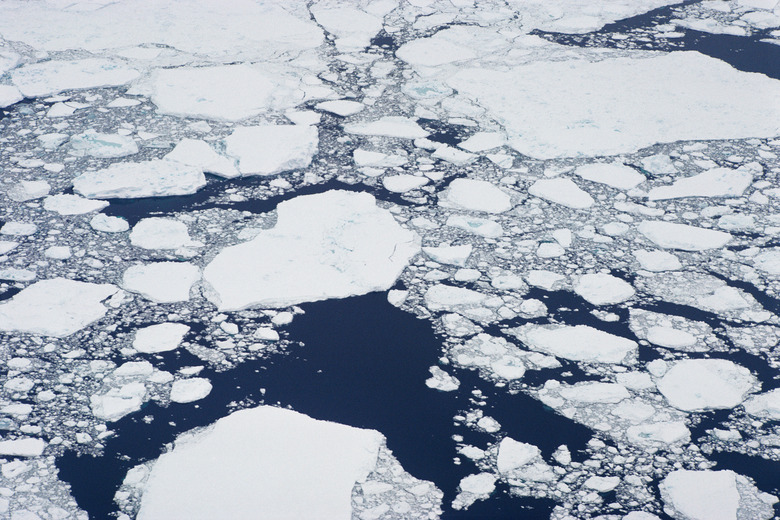Is The Narwhal An Endangered Species?
The whorled tusk of the narwhal may have contributed to the legend of the mythical unicorn, but the real flesh-and-blood animal is hardly less fantastical. This unusual toothed whale inhabits the high polar seas of the Arctic Ocean, traveling in large groups called pods and sometimes diving to remarkable depths. While it is not endangered, the narwhal is considered "near threatened" by the International Union for Conservation of Nature, or IUCN, which gauges a species' risk of extinction.
Narwhal Basics
Narwhal Basics
The word "narwhal" comes from the Norse, meaning "corpse whale" – a reference to the pallid tone of the animal's hide, suggestive of the look of a drowned human, although nowadays people are more likely to recognize it as "the whale with a horn." Narwhals belong to a small family of toothed whales, the Monodontidae, the only other member of which is the tusk-less beluga whale, also called the white whale. Narwhals are roughly cigar-shaped, with a blunt head, a pair of small flippers and convex tail flukes. In place of a dorsal fin the whales have a shallow ridge running along the tail-ward half of their back. Only the males typically possess a tusk, although the rare female may grow one; the modified tooth may exceed 3 meters (9.8 feet) in length and weigh 10 kilograms (22 lbs.). Not counting his tusk, a male narwhal reaches about 5 meters (16 feet) long and weighs 1600 kilograms (3,527 lbs.), while a female is a bit smaller. A newborn calf is speckled gray and a mature adult is usually darkly mottled on the head, back and tail; an old male may be virtually white.
Narwhal Population Distribution and Behavior
Narwhal Population Distribution and Behavior
Narwhals mostly inhabit the Arctic Ocean and its marginal seas above about 65 degrees north of latitude, primarily on the Atlantic side. These rare animals use the inlets, straits and embayments of the Canadian High Arctic and Greenland heavily – particularly the Davis Strait, Baffin Bay and the Greenland Sea – as well as the Russian Arctic. The whales annually migrate between winter range under the pack ice and ice-free, shallow-water summer range. They feed on squid, shrimp and fish such as halibut and cod, often diving to great depths – sometimes 1,800 meters (4,500 feet) or deeper – to forage. The purpose of the tusk isn't entirely known, but, judging from the occasional jousting observed between males, it likely helps establish dominance and breeding rights.
Natural Predators of the Narwhal
Natural Predators of the Narwhal
Narwhals have few predators, but they have been observed being hunted by orcas, or killer whales. For example, in the summer of 2005, a pod of orcas killed at least four narwhals in Admiralty Inlet in Nunavut, and researchers observed a number of defensive and avoidance strategies among narwhal groups in the area. Polar bears have been seen killing and eating stranded narwhals in the Canadian Arctic. Other potential predators include Greenland sharks – probably more important as scavengers of narwhal carcasses rather than active hunters – and walruses.
Threats and Status
Threats and Status
The IUCN notes that, while tens of thousands of narwhals still inhabit the Northern Hemisphere polar seas, the animals are potentially vulnerable to human activities and associated phenomena – the justification for the narwhal's "near threatened" status. Generally only opportunistically taken by whalers in the past, narwhals have been long hunted for subsistence in Canada and Greenland. The most notable and difficult-to-predict threat is climate change: By raising Arctic Ocean temperatures and depleting sea ice, global warming may affect narwhal food supply and habitat, as well as increase disruptive human shipping and natural-resource extraction in the whale's range. Some scientists speculate that the dwindling of pack ice may result in increased use of Arctic waters by orcas, which may accordingly boost predation on narwhals.
References
- The IUCN Red List of Threatened Species: Monodon monoceros
- National Oceanic and Atmospheric Administration: Ocean Explorer — The Biology and Ecology of Narwhals
- The Sierra Club Handbook of Whales and Dolphins; Stephen Leatherwood, Randall R. Reeves
- The Canadian Field-Naturalist; Reactions of Narwhals, Monodon monoceros, to Killer Whale, Orcinus orca, Attacks in the Eastern Canadian Arctic; Kristin L. Laidre, et al.
- Arctic; Predation of Belugas and Narwhals by Polar Bears in Nearshore Areas of the Canadian High Arctic; Thomas G. Smith, Becky Sjare
- Earth Times; Inuit Insight Into Killer Whale (Orcinus orca) Predation and Prey; Dave Armstrong
- National Oceanic and Atmospheric Administration: National Marine Mammal Laboratory — Narwhal Whales
Cite This Article
MLA
Shaw, Ethan. "Is The Narwhal An Endangered Species?" sciencing.com, https://www.sciencing.com/narwhal-endangered-species-6257/. 24 September 2018.
APA
Shaw, Ethan. (2018, September 24). Is The Narwhal An Endangered Species?. sciencing.com. Retrieved from https://www.sciencing.com/narwhal-endangered-species-6257/
Chicago
Shaw, Ethan. Is The Narwhal An Endangered Species? last modified March 24, 2022. https://www.sciencing.com/narwhal-endangered-species-6257/
